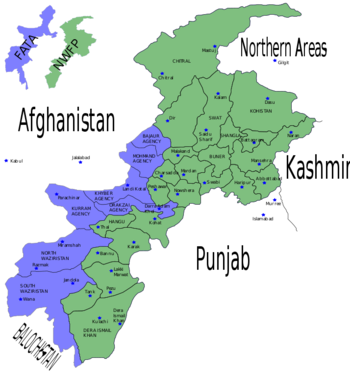Federally Administered Tribal Areas: Difference between revisions
John Leach (talk | contribs) m (Text replacement - "Federally Administered Tribal Areas" to "Federally Administered Tribal Area") |
John Leach (talk | contribs) (passed review) |
||
| (4 intermediate revisions by 2 users not shown) | |||
| Line 9: | Line 9: | ||
==References== | ==References== | ||
{{reflist|2}} | {{reflist|2}} | ||
[[Category:Reviewed Passed]] | |||
Revision as of 02:02, 22 February 2024
Federally Administered Tribal Area (FATA) was the name of a semi-autonomous region of Pakistan that existed from 1947 until 2018 when it was incorporated into the new province of Khyber Pakhtunkhwa, the former North-West Frontier Province (NWFP). The FATA region consisted of seven Tribal Agencies called Bajaur, Khyber, Kurram, Mohmand, Orakzai, North Waziristan, and South Waziristan. The agencies had a unique administrative and political status dating from British colonial rule in 1849 and were officially demarcated from Afghanistan in 1893 by the Durand Line. Governance was by federal political agents and, locally, by tribal elders.
According to the Pakistani government, the FATA was inhabited by about a dozen major tribes with several smaller tribes and sub-tribes. Utmankhel, Mohmand, Tarkani and Safi were the main tribes living in Bajaur and Mohmand. Afridi, Shilmani, Shinwari, Mulagori, and Orakzai were settled in Khyber and Orakzai. A mixture of Turi, Bangash, and Masozai inhabited Kurram. The main tribes of North and South Waziristan were Darwesh Khel Wazirs with a Mahsud community in the central part of the region. Among other FATA tribes were Utmanzai, Ahmadzai Dawar, Saidgai, Kharasin, and Gurbaz.[1]
It has been claimed that the FATA never had the same priority for economic development as the rest of Pakistan. Efforts were concentrated around sectoral facilities and the lack of economic development contributed to political isolation. Economic development programs, it was said, did not reflect "the FATA's evolving socio-economic landscape and power structure".[2]
References
- ↑ Tribal and ethnic diversity, Government of Pakistan
- ↑ Ijaz Khan, Challenges Facing Development in Pakistan’s FATA, NBR Analysis: Challenges Facing Pakistan’s Federally Administered Tribal Area (FATA), National Bureau of Asian Research (NBR), p. 14
